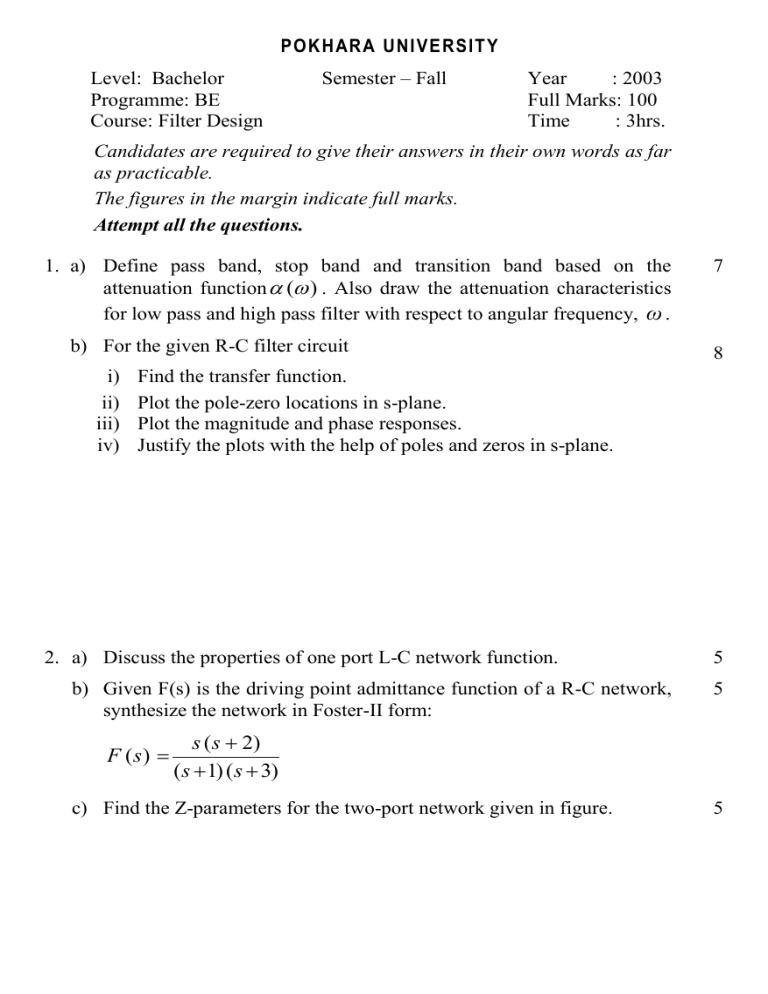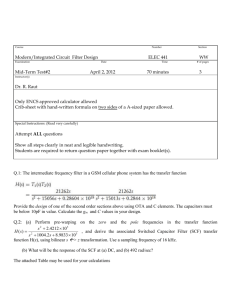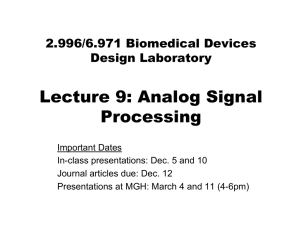FilterDesign

Level: Bachelor
Programme: BE
Course: Filter Design
POKHARA UNIVERSITY
Semester – Fall Year : 2003
Full Marks: 100
Time : 3hrs.
Candidates are required to give their answers in their own words as far as practicable.
The figures in the margin indicate full marks.
Attempt all the questions.
1.
a) Define pass band, stop band and transition band based on the attenuation function
(
) . Also draw the attenuation characteristics for low pass and high pass filter with respect to angular frequency,
ω
. b) For the given R-C filter circuit i) Find the transfer function. ii) Plot the pole-zero locations in s-plane. iii) Plot the magnitude and phase responses. iv) Justify the plots with the help of poles and zeros in s-plane.
2.
a) Discuss the properties of one port L-C network function. b) Given F(s) is the driving point admittance function of a R-C network, synthesize the network in Foster-II form:
F ( s )
s ( s
2
( s
1 ) ( s
)
3 ) c) Find the Z-parameters for the two-port network given in figure.
7
8
5
5
5
3.
a) Discuss Inverse-Chebyshev approximation in filter design.
Differentiate between Chebyshev and Inverse-Chebyshev approximations. b) Determine the order of he Chebyshev reponse that realizes the following specifications. i) The passband extends from
ω
0 to
ω
250 rad/s.
attenuation within the passband should not exceed 0.1 dB.
The ii) The response must give at least 60-dB attenuation at the frequency
ω
2000 rad/s or higher.
Also find the half power frequency.
4.
a) Realize the following transfer function by using Inverting op-amp only. T ( s )
2
(
( s s
1
2 )
)
Also find the element values in practical range by choosing suitable factor for magnitude as well as frequency scaling. b) Design a circuit to satisfy the requirements shown in figure by using suitable op-amp configuration.
5.
a) Explain how second order low-pass transfer function can be achieved in Tow-Thomas Biquad and what do you mean by orthogonal turning of this Biquad circuit? b) How gain adjustments are made? Explain. Apply the gain adjustment method in Sallen-Key Biquad circuit for which K = 3- 1/Q, where K is gain of the circuit and Q is quality factor.
6.
a) Why filter element sensitivites are important in filter design? Discuss single-parameter and multi-parameter sensitivities in detail. b) Design a fourth order Butterworth Low-pass filter with high cut-off
8
7
8
7
8
7
8
7
frequency are: ( s
2
1
KHz
0 .
765 s
1 ) ( s
2
.The normalized Butterworth polynomials
1 .
848 s
1 ).
7.
Write short notes (Any Two) . a) Storch method of finding Bessel-Thomson polynomials. b) Resisitive gain enhancement in Sallen-Key active filter. c) Generalized impedance converter (GIC) d) Advantages of Active filter over Passive filter.
10











